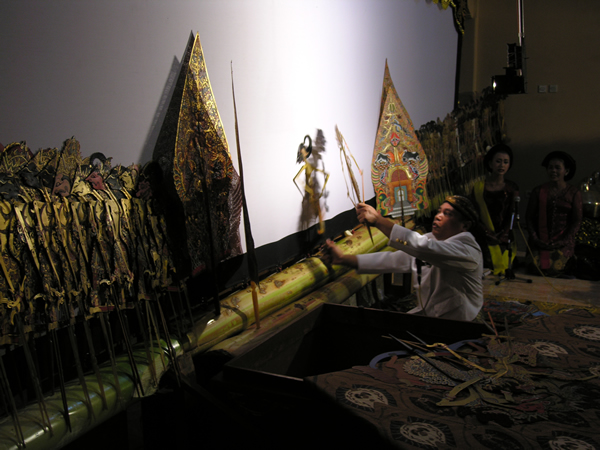The Dhalang (Puppeteer)
As the central artist of wayang kulit, the dhalang really makes the wayang and the performance come alive. He (commonly, but not exclusively male) manipulates every character, conducts the gamelan orchestra, and sometimes makes puppets or designs them. These skills are usually passed from generation to generation, and today many dhalang enhance their training by attending a formal art institute with degree programs in dhalang studies.Each dhalang brings his own style, humor, and innovation to the performance, providing for a unique experience at every show. Traditional wayang kulit performances last all night, averaging nine hours, without an intermission or break. The dhalang remains seated, in a cross-legged position, facing the screen in front of him and his voice remains strong and clear. These abilities demonstrate the stamina and strength of the individual dhalang.
Audiences of wayang kulit are not “tuned in” for the duration of the show. People walk around, socialize, nap, eat, come and go. Spectators depend on cues from the dhalang to pull their attention back to the performance for important scenes.
Truly, the dhalang is a master. He is a puppet master, a shadow master, a literary and linguistics master, and a leader. He is an entertainer who must have a strong voice for songs and poetic narration, and a strong sense of humor for telling effective jokes. The dhalang is also a political analyst and commentator on current affairs. However, his ultimate role is that of teacher. His foremost responsibility is to inform people about wayang kulit — the meaning of the puppets, the philosophy behind the stories, cultural values, and the mysteries of the universe and human nature.
It is for their extraordinary artistic talents and philosophical insights that dhalang are highly respected in their culture and regarded as spiritual people.
Gamelan in Wayang Kulit Performance
The gamelan orchestra is a vital accompaniment for wayang kulit performance. Music supports the all-night performance almost non-stop, though the number of instruments that play may vary. Gamelan serves both musical and dramatic functions -- music sets the mood, interprets, and reinforces various aspects of the dhalang’s narrative. The entrances and exits of particular characters to the stage, journeys, battles, and narrations are accompanied by musical compositions of various lengths. At certain junctures of the play, the dhalang chants or sings songs (called sulukan) to set the mood of the scene, which is accompanied by soft-sounding instruments.Among the many instruments in the ensemble, the most important for wayang kulit is the gendér. This metallophone accompanies all narratives, sulukan, and musical compositions. Because of the importance of this instrument, it is always positioned directly behind the dhalang.
Also essential to wayang performance is the kendhang, a drum. The kendhang sets the tempo of the music and the puppets’ dances. Tempo signifies dramatic action: loud, accelerated music bolsters the intensity of the drama, whereas soft music, with a slow tempo, serves as background music for the dhalang’s narration or an important character’s recitation. Changes in the tempo are led by the kendhang when the drummer receives a cue from the dhalang.
The three acts in wayang kulit performance parallel the mood progression of the three modes of music: Pathet Nem, Pathet Sanga, and Pathet Manyura. These three acts also symbolize stages and spiritual developments in the life of the story’s hero.
 |
| The bonang section of a gamelan orchestra. |

